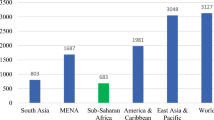
Overview
Access this book
Tax calculation will be finalised at checkout
Other ways to access
About this book
Similar content being viewed by others
Keywords
Table of contents (11 chapters)
-
Front Matter
-
Introduction
-
Infrastructure, Growth, and the MDGs
-
Front Matter
-
-
What Did Past Reforms Achieve and What’s Next?
-
Front Matter
-
-
Back Matter
Reviews
"This book is the most comprehensive book so far on infrastructure and the poor in Sub-Saharan Africa. It combines accessible theoretical reasoning with a firm grip on empirical evidence. After reviewing the role of infrastructure on growth, it documents access rate to infrastructure services, affordability, quality, and costs. It also discusses the scope for reforms to improve the support to the poor. The book is simultaneously rigorous and easy to read. This is an essential contribution for anyone who is interested in development economics and poverty alleviation." - Emmanuelle Auriol, Professor of Economics, Toulouse School of Economics, France
"This book challenges the development community to start thinking more objectively about how we deliver infrastructure to benefit the poor. It is not about private vs. public but using the available evidence to understand the challenges and the potential solutions to deliver more effective services to the poorest people in society." - John Hawkins, Programme Manager, Engineers Against Poverty, UK
"This is essential reading for those wanting to understand the infrastructure challenge facing Africa and how to meet it. The authors quantify the challenge, assess the effectiveness of past reforms, and outline a strategy for delivering infrastructure that will support growth and meet the needs of the poor. A long overdue book that will shape future policies." - Tony Venables, BP Professor of Economics, University ofOxford, UK
"The development of Africa and its infrastructure is on everyone's agenda, but progress has been excruciatingly slow. In their sobering and important book Estache and Wodon focus on how Africa's poor have been affected by recent infrastructure reforms and what reforms to try next. They estimate that the poor have seen the least increase in access to modern infrastructure, and as a consequence often pay more for inferior substitutes, travel longer to schools and clinics and suffer poorer educational and health outcomes. To improve access African states need to move beyond the debate on privatization and develop a portfolio of approaches including small local private providers as well as large, renewed efforts to improve the performance of state-owned infrastructure companies and reforms to traditional government procurement practices. In addition, states should restructure tariffs to target aid to the poor by, for example, switching from consumption to connection subsidies." - Jose A. Gomez-Ibanez, Derek C. Bok Professor of Urban Planning and Public Policy, Harvard University, USA
About the authors
Bibliographic Information
Book Title: Infrastructure and Poverty in Sub-Saharan Africa
Authors: Antonio Estache, Quentin Wodon
DOI: https://doi.org/10.1057/9781137348487
Publisher: Palgrave Macmillan New York
eBook Packages: Palgrave Economics & Finance Collection, Economics and Finance (R0)
Copyright Information: Palgrave Macmillan, a division of Nature America Inc. 2014
Hardcover ISBN: 978-1-137-38149-1Published: 19 November 2014
Softcover ISBN: 978-1-349-47964-1Published: 19 November 2014
eBook ISBN: 978-1-137-34848-7Published: 19 November 2014
Edition Number: 1
Number of Pages: XVIII, 190
Topics: Development Economics, Economic Policy, Economic Theory/Quantitative Economics/Mathematical Methods, Macroeconomics/Monetary Economics//Financial Economics, International Political Economy, Development Aid



